Abstract
Microplastics contained in laundry wastewater are identified as the main cause of marine microplastics, accounting for approximately 35% of marine microplastics. In this study, a four-stage microplastic filter for laundry wastewater was developed and the removal rates of microplastics, COD, SS, and turbidity were checked through 50 tests to confirm the efficiency of the filter. The microplastic removal rate was confirmed using μFTIR with a high efficiency of 98.5% on average for 50 tests. The microplastics contained in laundry wastewater were identified as 57% PE, 9% PET, 9% PA, 8% PU, 8% PP, 6% PPMA, and 3% PAN. COD was measured using the COD manganese method, and the COD removal rate of the laundry wastewater filter was an average of 92% for 50 times. SS was verified by filtration using a vacuum pump and the average removal rate was 80% during 50 tests. Turbidity was confirmed with an average removal rate of 88% using a turbidity meter. As a result of the experiment, it was confirmed that when the developed filter was installed in laundry wastewater, not only microplastics but also various water pollutants were reduced. In addition, the water quality pollution index showing the highest correlation with microplastics in laundry wastewater was SS, and the p-value was confirmed to be 0.000.
1. Introduction
Plastic pieces less than 5 mm in size, called microplastics, are an emerging major environmental pollution issue worldwide. In 2017, microplastic fibers released during the laundry process were found to account for approximately 35% of global microplastic marine pollution [1]. During the laundry process, microplastics are created as microfibers are mechanically and chemically separated, and it was confirmed that wastewater treatment plants cannot block all microfibers that are released due to their micro or nano size [2,3,4]. In order to reduce microplastics in the ocean, it is necessary to reduce microplastics in laundry wastewater, and preventive measures include improving washing machine technology, using filters, and changing clothing materials. Among these, the most efficient method that can be applied to existing washing machines is a laundry water filter. There are several factors that contribute to the creation of microfibers during laundry. First, it was confirmed that clothing made from natural fabrics releases more microfibers when washed than clothing made from synthetic fabrics [5]. Second, the age of clothing can affect microfiber shedding. Several studies have found that new clothes release more microfibers than old ones [6,7]; however, Hernandez (2017) found that older clothes released more microfibers than new clothes depending on the type of clothing [8]. Third, it was confirmed that the discharge of microfibers differs depending on the temperature of the laundry water and the type of laundry machine. Several studies have shown that hot washing results in more microfibers being released than cold washing [5,9]. Depending on the type of laundry machine, top-loader types (regular laundry machines) were found to emit more microfibers than front-loader types (drum laundry machines) [10,11]. Fourth, the amount of clothes for washing significantly affected the release of microfibers. Volgare et al. (2021) confirmed that as the washing load increased, friction decreased and microfiber release decreased, and when the washing load decreased, microfiber release increased by about 5 times due to increased mechanical stress [12]. Additionally, microfiber release increased or decreased depending on the type of detergent, fabric softener, and laundry machine operation method [13,14].
Accordingly, there are several ways to alleviate microplastic pollution in laundry wastewater. First, there are improvement measures by consumers and suppliers, such as reducing the number of washes, reducing clothing consumption, and changing textile production methods. Second, washing machine suppliers are taking steps to improve their washing machines, such as changing washing methods, developing new washing machines with a new filtration system, conserving water, and improving detergents. However, both methods are not easy to apply to general households. Accordingly, the most important priority approach to reduce microfiber emissions is to develop a laundry machine-specific filter and install it at the back of the laundry water discharge port to filter and release it out.
Global plastic use has increased steadily since the 1960s, reaching 367 million tons in 2020 and is expected to continually increase [6]. The increase in the use of plastics is accelerating the rapid increase in microplastics. In particular, it can lead to an increase in marine microplastics, which is the final stage.
Many researchers are conducting research on the method of microfiber emission, the source and path, and the method of removing microfibers from the emission source to study the control method of microplastics [15,16,17]. In particular, several studies were conducted on microplastic removal methods in sewage treatment plants where laundry wastewater is primarily discharged and controlled [18,19]. Traditional secondary and tertiary wastewater treatment was shown to remove up to 98% of microplastics in water [20]. Alvitie et al. (2017) confirmed that 99% of microplastics were removed using a 0.4 μm membrane and a biologically active filter [21]. Murphy et al. (2016) reported that despite a 98% removal of microplastics in a Scottish WWTP, approximately 6.5 × 107 MPs were still released into the aquatic environment every day [2]. Despite the removal of microplastics in sewage treatment plants, millions of microplastics are still being released into rivers every day. While many studies have focused on removing microplastics in wastewater treatment plants, few practical strategies have been proposed to reduce emissions during household laundry processes. In addition, research on the efficiency, economic feasibility, and practicality of laundry water filters is limited.
In this study, our aim is to reduce microplastics in laundry water by developing a microplastic filter that is installed on the laundry machine outlet. The microplastic filter was developed as a four-stage filter. The first filter is a 1270 μm stainless steel filter that mainly removes large microfibers, and the second filter is a 508 μm stainless steel filter that removes microplastics that were not removed in the first stage. The third filter is a 101 μm stainless steel filter that removes microfibers larger than 100 μm. The fourth filter is a 0.3 μm glass fiber filter that removes microplastics smaller than 100 μm. The developed filter can be installed on the washing water drain outlet to be compatible with various washing machine models for expandability, and the maximum lifespan of the filter was measured for practicality to confirm the replacement period and maintenance method of the filter. This filtration filter system is a groundbreaking technology that can reduce microplastics, turbidity, SS, and COD in laundry wastewater. In order to verify the efficiency of the filtration system, microplastics, turbidity, SS, and COD in laundry wastewater were checked before and after treatment.
2. Materials and Methods
The test method was divided into a manufacturing section for the laundry wastewater filter to explain the structure of the developed filter and an experimental section to confirm the removal of microplastics and other pollutants using the developed filter.
2.1. Filter Developing Method
The developed laundry wastewater filter was manufactured to filter approximately 15 L/min of washing machine wastewater. It was manufactured as a four-stage filtration system that can remove microplastics, suspended solids, and other contaminants. Before manufacturing the product, it was designed as shown in Figure 1 to remove microfibers step by step through the cyclone water flow.
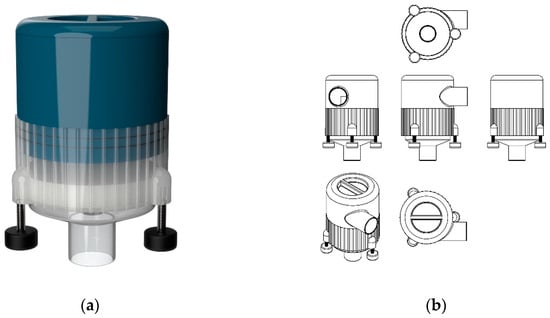
Figure 1.
Laundry filter design: (a) laundry filter design rendering image; (b) design of laundry filter drawing.
After designing the product, modeling was performed using Soildworks 2024 to evaluate the performance of the product and check the water flow of the virtual product, as shown in Figure 2. In the results, it was confirmed that the product was designed in a circular shape, and the physical separation occurred quickly due to the acceleration and gravity generated from the high flow rate from the centrifuge, which increased the removal efficiency of microplastics and suspended solids.

Figure 2.
Laundry filter fluid modeling using Solidworks 2024: (a) laundry filter 3D image; (b) top view of laundry filter fluid flow; (c) side view of laundry filter fluid flow; (d) velocity view of laundry filter fluid flow.
Based on the modeling results, the laundry wastewater filter was manufactured as shown in Figure 3. The filter parts were designed and manufactured by dividing them into four filter nets, a part connected to the washing machine, and a part connected to the drain. The primary filter is a net-shaped woven wire made of stainless steel 304 with a pore diameter of 1270 μm. The secondary filter is also made of stainless steel 304 and has a pore diameter of 508 μm. The tertiary filter is also made of stainless steel 304 and has a pore diameter of 100 μm. The 4th filter is a 0.3 μm filter made of glass fiber. All filters are designed and custom-made according to the dimensions. The manufactured product can be inserted directly into the sewage outlet and connected to the washing machine drain hose. The water discharged from the washing machine passes through the developed filter and flows out to the sewage outlet.


Figure 3.
Laundry filter parts and manufacturing process: (a) filters used in laundry filter system; (b) parts used in laundry filter system; (c) assembled laundry filter system; (d) installed laundry filter system.
2.2. Laundry Wastewater Filter Efficiency Test Method
To test the replacement cycle and efficiency of the developed filter, 50 repeated experiments were performed and microplastics, COD, SS, and turbidity were analyzed in the discharge wastewater and the wastewater after filtration. The concentrations of microplastics, COD, SS, and turbidity in the laundry discharge water before and after the filter were compared to verify the removal efficiency of the filter. The laundry was performed at 5 kg/load using general clothing, towels, and socks.
2.2.1. Microplastic Analytical Method
Microplastic analysis was performed using a Fourier transform infrared (FTIR) microscope (IN10MX, Thermo Fisher Scientific Inc., Waltham, MA, USA) and a digital microscope (DSZM-7045T, Dongwon Industries, Seoul, Republic of Korea). The microplastic filter used was made of stainless steel with a pore size of 20 μm and a diameter of 25 mm. It was vacuum-filtered and measured using an FTIR microscope.
Raman spectroscopy, pyrolysis GC-MS, and uFTIR are widely used methods for analyzing microplastics. uFTIR can analyze small particles less than 20 μm in high resolution based on the unique vibration spectrum of the polymer without damaging the sample, so it was selected as suitable for laundry wastewater. Pyrolysis GC-MS was excluded because it could not confirm the shape and particle size of microplastics, and Raman spectroscopy was excluded because it can cause fluorescence interference from colored microfibers or specific polymers. Cross-validation was considered using Raman spectroscopy and u-FTIR, but since it required many experiments, it was decided to proceed when commercializing the filter product.
Figure 4 shows microplastic analysis sequence using μFTIR. FTIR microscopy analyzes one quarter of a 25 mm mass filter at a time, and the entire filter is analyzed four times. The number, material, and length of microplastics in the analyzed filter were confirmed using FTIR microscope software. The type of microplastic was determined based on the FTIR spectra data provided by the FTIR software. The plastic type criterion is determined to be a specific plastic type if the match rate is 70% or higher and the same plastic is found more than 10 times. The size of microplastics was measured by their longest length (maximum ferret diameter) [22].
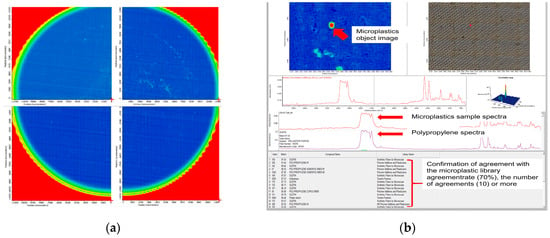
Figure 4.
Microplastic mesh filter image and microplastic identification process. (a) 25 mm mesh filter used for analysis of microplastics, imaged by FTIR microscope. (b) Determination of microplastics using OMNIC 9.16.
To check the microfiber removal rate of the laundry filter, the difference before and after passing through the laundry filter was determined in the form of the following formula:
2.2.2. Chemical Oxygen Demand Analytical Method
Chemical oxygen demand, called COD, was measured before and after passing through the laundry filter to confirm the organic matter removal rate of the laundry filter. COD is used as an indicator to determine the amount of dissolved oxygen needed to oxidize organic matter in water with an oxidizing agent [23,24]. The COD manganese method was used to check how much COD the laundry water filter removes. The COD manganese method is a method of measuring the amount of oxygen consumed by adding 0.025 N potassium permanganate to a wash water sample, heating it in a water bath for 30 min, and then checking the amount of potassium permanganate consumed. The COD removal rate was confirmed by measuring the difference in COD between the laundry discharge water before and after passing through the filter. The removal rate was determined in the form of the following formula:
2.2.3. Suspended Solid Analytical Method
Suspended solid, called SS, was measured before and after passing through the developed laundry filter to confirm the total suspended solid removal rate of the developed filter. SS is used as an indicator to check suspended solids in water [25]. SS was used as an indicator to check how efficient the filter is in removing microplastics and other floating pollutants. The measurement method used was to shake 1 L of laundry discharge water using a glass fiber filter and then filter 250 mL of water using a vacuum pump to check the weight difference in the glass fiber filter before and after the experiment. The difference was confirmed by measuring the laundry discharge water before and after passing through the filter to check the SS removal rate of the laundry wastewater filter. The removal rate was determined in the form of the following formula:
2.2.4. Turbidity Analytical Method
The difference in turbidity before and after the laundry filter was checked to confirm the turbidity removal rate of the developed laundry filter. The turbidity was measured using a turbidity meter (2100Q, HACH, Hach company, Loveland, CO, USA). The turbidity removal rate was calculated by using the difference before and after passing through the laundry filter in the form of the following formula:
3. Results
Microplastics, COD, and SS were analyzed, and the results were derived to evaluate the effect and efficiency of the microplastic filter on the number of laundry cycles. The unit of microplastics was expressed as MPs ea/L, the units of COD and SS were calculated as mg/L, and the unit of turbidity was NTU. The process of the laundry machine consists of the first washing, first rinsing, second rinsing, and dehydration process, and the analysis of microplastics, COD, and SS was performed on the effluent after the first washing. The removal rates of all analyzed pollutants were calculated before and after passing through the developed filter. Additionally, the developed filter was not cleaned or replaced for 50 washes.
3.1. Microplastic Analysis
The experiment on microplastics in laundry wastewater was conducted 50 times with 5 kg/load of laundry after installing the developed filter at the rear of the washing machine. The results are shown in Figure 5.
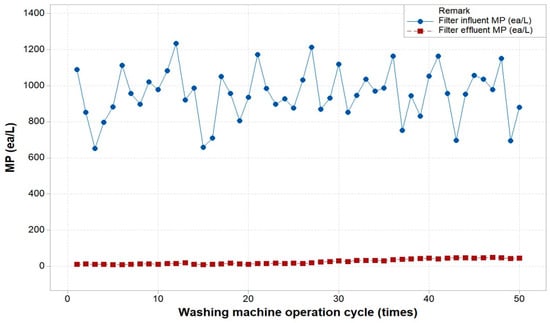
Figure 5.
Amount of microplastics by number of washes.
The maximum microplastics flowing into the wash wastewater was 1235 MPs ea/L, the minimum was 652 MPs ea/L, and the average was 954 MPs ea/L. These numbers were significantly different with each wash. The maximum microplastics flowing out through the developed wash filter was 48 MPs ea/L, the minimum was 8 MPs ea/L, and the average was 24 MPs ea/L. This result confirmed that there was a constant filter efficiency regardless of the number of microplastics before the filtration of laundry wastewater. The microplastic removal rate was confirmed by using Equation (1) to determine the number of microplastics before and after the filtration. The microplastic removal rate was calculated to be 97% on average.
In Figure 5, the number of microplastics detected in the wash wastewater passing through the microplastic filter slightly increased as the number of washes increased. After filtering 28 times, more than 23 MPs ea/L of microplastics were detected in the discharge water. The maximum number of microplastics was 48 MPs ea/L, which was confirmed to be more than 5 times higher than the minimum of 8 MPs ea/L. However, the microplastic removal rate was still more than 93% when compared to the inflow water. The result indicates that the efficiency of the washing filter does not have a large effect on the microplastic removal rate even for 50 washes. As shown in Figure 6, the removal rate of microplastics was confirmed to be a maximum of 99% and a minimum of 93%. This means that the microplastic filter can remove more than 90% of microplastics even when used without any maintenance for 50 washes. According to a survey on washing machines, it was confirmed that 67% of people in the world use washing machines twice a week on average [26]. The microplastic filter developed based on this was confirmed to have the performance to remove microplastics regardless of filter replacement when used for 25 weeks (approximately 6 months). Therefore, the filter replacement cycle is 1 time per 6 months when using the washing machine twice a week, and 2 times per year when using the washing machine three times a week with a replacement cycle of about 4 months. The types of microplastics in the washing machine were inferred by checking the types of microplastics in the effluent after the washing machine filter, as there were too many microplastics in the effluent before the filtration. The types of microplastics were confirmed to be PE 57%, PET 9%, PA 9%, PU 8%, PP 8%, PPMA 6%, and PAN 3% at an average of 50 times, as shown in Figure 7. The result can be inferred to be the most commonly used fiber material and the most commonly included fiber in clothing. In addition, PET, PA, and PU materials are also widely used as synthetic fibers in clothing. Figure 8 shows photos of discharged microplastics during washing taken with a digital microscope. As shown in the microscope photos, a significant number of microplastics in the washing water were filament-shaped.
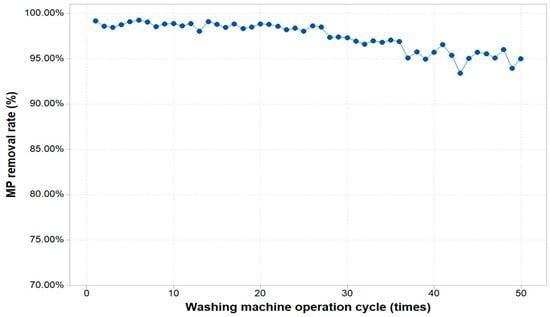
Figure 6.
Removal rate of microplastics by number of washes.
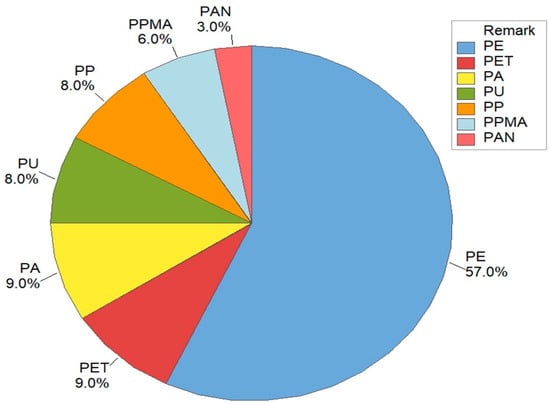
Figure 7.
Types of microplastics.
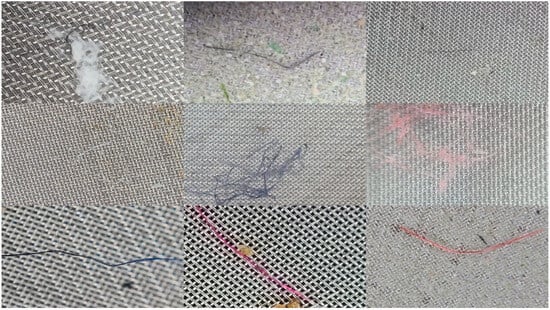
Figure 8.
Photos of microplastics in laundry wastewater using digital microscope.
3.2. Chemical Oxygen Demend Analysis
High COD in laundry wastewater can be a cause of river pollution and can overload wastewater treatment plants [27]. Therefore, COD removal from laundry effluent can play many roles, such as reducing the level of pollution in wastewater from sewage treatment plants, reducing the use of water treatment chemicals in sewage treatment plants, and reducing wastewater load.
During the 50 experiments, the COD of the washing water flowing out before using the filter was confirmed to be a maximum of 335 mg/L, a minimum of 119 mg/L, and an average of 296 mg/L, which was significantly different for each wash in Figure 9. The COD of the washing wastewater flowing out after the microplastic filter was confirmed to be a maximum of 33 mg/L, a minimum of 13 mg/L, and an average of 25 mg/L, and it was confirmed not to be changed much. The COD removal efficiency of the developed filter was confirmed to be an average of 92%.
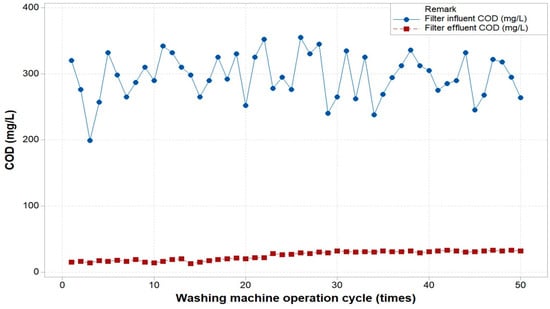
Figure 9.
Amount of COD by number of washes.
Figure 10 shows that the COD removal efficiency decreases slightly as the number of washes increases. However, it was determined that the COD removal efficiency remains above 87% even after 50 washes.
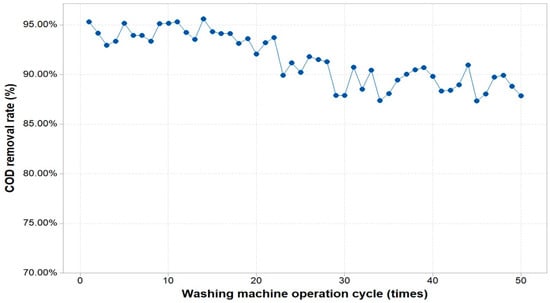
Figure 10.
Removal rate of COD by number of washes.
A large amount of water is used as laundry wastewater. It is expected that the COD of contaminated water can be reduced by an average of 90% or more when using the currently developed laundry filter, which will reduce the load on sewage treatment plants for laundry wastewater by approximately 90%.
3.3. Suspended Soild Analysis
SS of laundry wastewater is composed of organic and inorganic substances. SS can be used as a tool to easily check water quality pollution of laundry wastewater.
In Figure 11, the SS before the filter of the laundry discharge water after 50 experiments was confirmed to have a large fluctuation, with a maximum of 151 mg/L, a minimum of 79 mg/L, and an average of 110 mg/L. The SS of the laundry discharge water after filtration through the developed filter was confirmed to have high removal efficiencies, with a maximum of 21 mg/L, a minimum of 2 mg/L, and an average of 12 mg/L. Accordingly, the SS removal efficiency using Equation (3) was determined and was shown in Figure 12. The SS removal rate after using the laundry filter was confirmed to be high, with an average of 89%. It was confirmed that the SS removal efficiency was maintained at a high level of over 80% even after using the developed laundry filter more than 50 times. This is a technology that can reduce the SS of laundry wastewater by 80%, which can reduce the amount of coagulant used in sewage treatment plants.
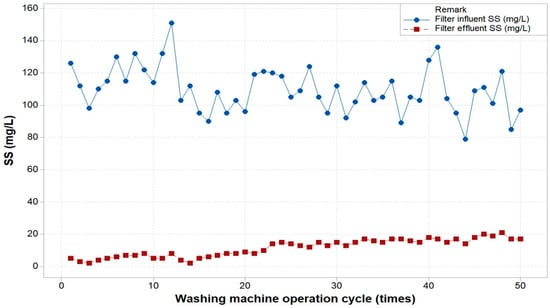
Figure 11.
Amount of SS by number of washes.
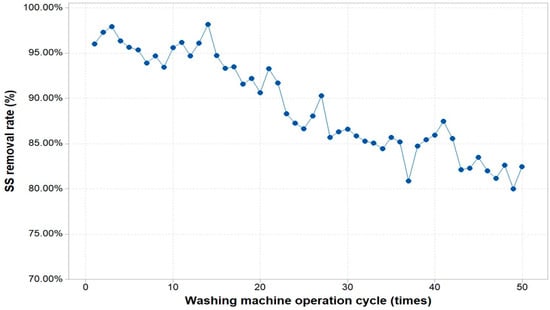
Figure 12.
Removal rate of SS by number of washes.
3.4. Turbidity Analysis
Turbidity is a basic standard that can be used to simply measure water quality by checking the degree of turbidity of a liquid. As a result of 50 experiments, the turbidity of the wash water before using the filter was confirmed to be a maximum of 98 NTU, a minimum of 62 NTU, and an average of 84 NTU, with a maximum difference of 36 NTU, as shown in Figure 13. The turbidity of the laundry discharge water after the filter was confirmed to be a maximum of 17 NTU, a minimum of 2 NTU, and an average of 10 NTU, with a maximum difference of 15 NTU. Accordingly, by applying Equation (4), the turbidity removal efficiency was confirmed to be an average of 88%.
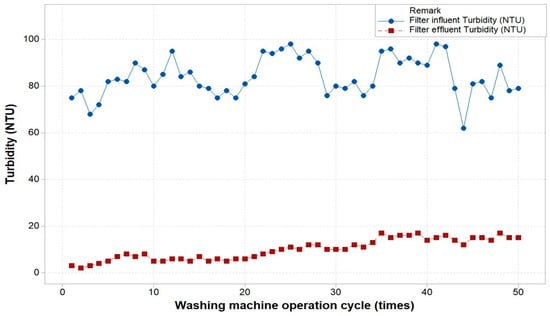
Figure 13.
Amount of turbidity by number of washes.
In Figure 14, the turbidity removal rate began to fall below 90% in the 25th cycle and showed a removal efficiency of 81% in the 50th cycle. The highest SS removal efficiency was 97% in the 2nd cycle, and the minimum efficiency was confirmed to be 81% in the 39th cycle. The minimum efficiency of 81% can be considered high efficiency considering the SS concentration of the washing water going to the sewage treatment plant. Accordingly, it was confirmed that the turbidity removal of the filter maintained high efficiency even after 50 test cycles.
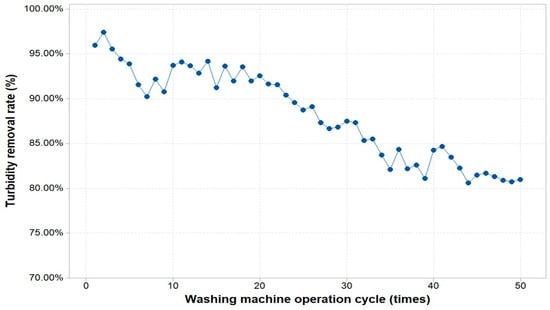
Figure 14.
Removal rate of turbidity by number of washes.
4. Discussion
In this experiment, the average amount of microplastics generated during laundry was confirmed to be 954 MPs ea/L based on 5 kg/1 load. These microplastics enter sewage treatment plants and are not completely removed, so they are released into rivers and the sea. According to J Ba yo. 2023, the microplastic removal efficiency of sewage treatment plants was confirmed to be at least 64.3% to 89.2% [28]. Despite these treatments, 93 million and 8.2 billion microplastics are released into the ocean, rivers, and seas [29]. Household laundry water contains many water pollutants such as surfactants, organic dyes, nitrogen, phosphorus, alkalis, bleach, pathogens, and microplastics [30]. These components increase the wastewater pollution load on sewage treatment plants and increase treatment costs. Accordingly, minimal contamination of laundry wastewater is an important factor.
Most household microplastics come from laundry wastewater. Washing water accounts for 15 to 20% of the water used in households [31]. The total amount of laundry wastewater discharged annually in China is about 10.71 billion tons [32]. The European Union, EU, industrial laundry sector washes 2.7 billion kg of textiles per year (wet weight) and uses 42 million m3 of water, which ends up in sewage as wastewater [33]. Accordingly, in this study, we developed a washing machine microplastic filter and conducted 50 experiments at 5 kg/load using an actual washing machine. The developed washing water microplastic removal filter showed a high microplastic removal rate of 97% on average. These results are higher than the capture rate of 89% of microfibers by Filtrol 160 (Wexco Environmental, MN, USA) using a commercially available 100 μm polyester mesh [16] and higher than the capture rate of up to 87% by the developed washing machine filter [15,34].
In this experiment, we additionally confirmed COD, SS, and turbidity in the wash wastewater, which were not confirmed in the existing microfiber filter experiments. The wash wastewater passing through the developed microplastic filter showed an average removal rate of 91% for COD, 89% for SS, and 88% for turbidity. This is a very high treatment rate, confirming that it can reduce the direct load on wastewater pollutants in sewage treatment plants. In addition, we verified the sustainability of the efficiency of the wash filter by conducting the experiment at 5 kg/load for 50 times. Although the treatment rate decreased slightly as the number of operations increased, we were able to confirm an average treatment rate of over 88% for all pollutants.
Based on the results of this experiment, the significance probabilities of microplastics and COD, SS, and turbidity were confirmed. The probability value (p-value) according to the number of microplastics discharged from the washing wastewater was confirmed to be 0.038 for COD, 0.000 for SS, and 0.012 for turbidity. A p-value of 0.05 or less is reported to have a significant correlation. Therefore, it was confirmed that COD, SS, and turbidity were all correlated with the number of microplastic discharge. Among them, the p-value of SS was confirmed to have the highest correlation with microplastics at 0.000, and COD was confirmed to have the lowest correlation at 0.038, as shown in Figure 15.
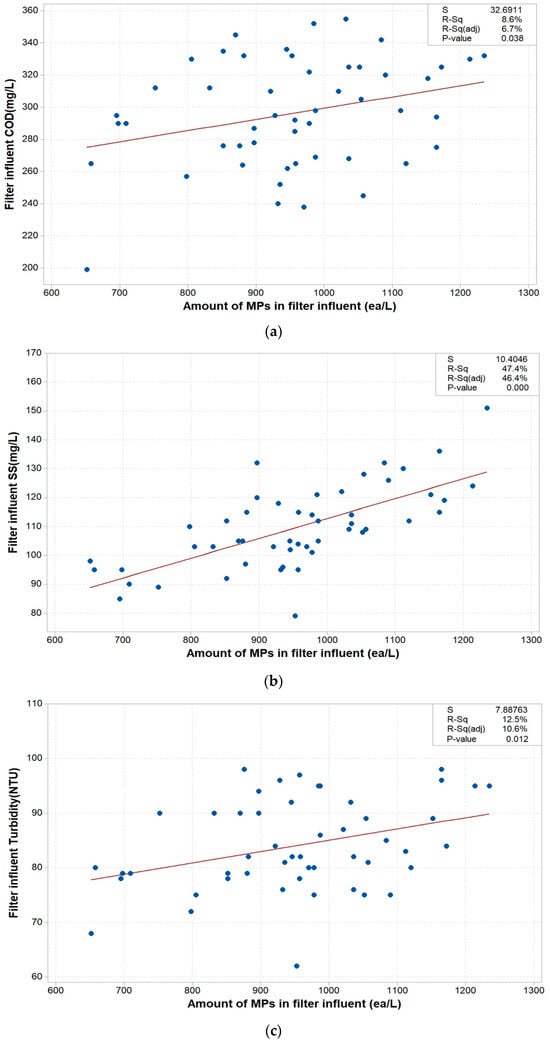
Figure 15.
Correlation between microplastics and water pollutants: (a) COD vs. MPs; (b) SS vs. MPs; (c) turbidity vs. MPs.
Through this study, we were able to confirm that when using the developed filter, not only microplastics but also water pollutants such as COD, SS, and turbidity were effectively removed.
In order to commercialize the developed filter, various methods are being explored to check the flow reduction, clogging problems, and maintenance requirements. The flow reduction will be minimized by adjusting the filter hole size to remove particles by size. The clogging problem will be solved by adding a pretreatment filter with large holes in the initial stage of large fibers or debris, and a maintenance manual that allows for periodic cleaning of the filter will be created and reflected. For easier maintenance, the design of the filter is being changed to make it easy to clean or replace, and a notification system that notifies the user when the filter needs to be cleaned or replaced is also being considered.
5. Conclusions
In this study, the removal rate of microplastics and the removal characteristics of COD, SS, and turbidity of the developed laundry filter were investigated. The pollutant removal efficiency of the microplastic filter was confirmed with a total of 50 time tests at 5 kg/load, and the results have the following findings:
1. A microplastic removal filter exclusively for washing machines with a four-stage filtration system was developed. The developed filter is installed in a domestic sewer and connected to the washing machine.
2. The removal rate of microplastics using the microplastic filter is a high efficiency of 98.5% on average during 50 washes, and the filter can be used for 4 to 6 months without maintenance.
3. The possibility of the microplastic filter removing various water pollutants as well as microplastics was confirmed by COD average removal of 92%, SS average removal of 80%, and turbidity average removal of 88%.
4. The installation of the developed filter for washing discharge water can remove many water pollutants, so it is an important factor in reducing the water pollution load of sewage treatment plants.
5. Microplastics in laundry water and SS have a high correlation of p-value at 0.000.
These results confirm that there is one way to reduce microplastics caused by laundry discharge water, which accounts for 35% of ocean pollution. The laundry wastewater filter can have a significant reduction on the water quality pollution load of sewage treatment plants. However, legislation, innovation, and awareness changes to regulate microplastics are needed to implement the developed filters. In addition, the development of an industry-use microplastic filter is also an urgent issue and could help prevent marine pollution by microplastics.
Author Contributions
Conceptualization, H.P. and B.P.; methodology, B.P. and H.-J.Y.; software, B.P.; validation, B.P., H.-J.Y. and H.P.; analysis, B.P. and H.-J.Y.; data collection, B.P. and H.-J.Y.; writing—original draft preparation, B.P. and H.-J.Y.; writing—review and editing, H.P.; supervision, H.P.; project administration, H.P.; funding acquisition, H.P. All authors have read and agreed to the published version of the manuscript.
Funding
This research was funded by the Korea Technology and Information Promotion Agency, grant number RS-2023-00256359.
Data Availability Statement
Data are contained within the article.
Conflicts of Interest
Authors Beomseok Park and Hanbai Park were employed by the company Korea Microplastic Research Center Co., Ltd. Author Hee-Jung Yoon was employed by the company Taeyoungunion Co., Ltd. The remaining authors declare that the research was conducted in the absence of any commercial or financial relationships that could be construed as a potential conflict of interest.
References
- Boucher, J.; Friot, D. Primary Microplastics in the Oceans: A Global Evaluation of Sources; IUCN: Gland, Switzerland, 2017; p. 43. [Google Scholar]
- Murphy, F.; Ewins, C.; Carbonnier, F.; Quinn, B. Wastewater treatment works (wwtw) as a source of microplastics in the aquatic environment. Environ. Sci. Technol. 2016, 50, 5800–5808. [Google Scholar] [CrossRef] [PubMed]
- Franco, A.A.; Arellano, J.M.; Albendín, G.; Rodríguez-barroso, R.; Quiroga, J.M.; Coello, M.D. Science of the total environment microplastic pollution in wastewater treatment plants in the city of Cádiz: Abundance, removal efficiency and presence in receiving water body. Sci. Total Environ. 2021, 776, 145795. [Google Scholar] [CrossRef]
- Conley, K.; Clum, A.; Deepe, J.; Lane, H.; Beckingham, B. Wastewater treatment plants as a source of microplastics to an urban estuary: Removal efficiencies and loading per capita over one year. Water Res. X 2019, 3, 100030. [Google Scholar] [CrossRef] [PubMed]
- Yang, L.; Qiao, F.; Lei, K.; Li, H.; Kang, Y.; Cui, S.; An, L. Microfiber release from different fabrics during washing. Environ. Pollut. 2019, 249, 136–143. [Google Scholar] [CrossRef] [PubMed]
- Cesa, F.S.; Turra, A.; Checon, H.H.; Leonardi, B.; Baruque-ramos, J. Laundering and textile parameters influence fibers release in household washings. Environ. Pollut. 2019, 257, 113553. [Google Scholar] [CrossRef]
- De Falco, F.; Di Pace, E.; Cocca, M.; Avella, M. The contribution of washing processes of synthetic clothes to microplastic pollution. Sci. Rep. 2019, 9, 1–11. [Google Scholar] [CrossRef]
- Hernandez, E.; Nowack, B.; Mitrano, D.M. Polyester Textiles as a Source of Microplastics from Households: A Mechanistic Study to Understand Microfiber Release during Washing. Environ. Sci. Technol. 2017, 51, 7036–7046. [Google Scholar] [CrossRef]
- Cotton, L.; Hayward, A.S.; Lant, N.J.; Blackburn, R.S. Improved garment longevity and reduced microfibre release are important sustainability benefits of laundering in colder and quicker washing machine cycles. Dye. Pigment. 2020, 177, 108120. [Google Scholar] [CrossRef]
- Hartline, N.L.; Bruce, N.J.; Karba, S.N.; Ru, E.O.; Sonar, S.U.; Holden, P.A. Microfiber masses recovered from conventional machine washing of new or aged garments. Environ. Sci. Technol. 2016, 50, 11532–11538. [Google Scholar] [CrossRef] [PubMed]
- Julapong, P.; Srichonphaisarn, P.; Meekoch, T.; Tabelin, C.B.; Juntarasakul, O.; Phengsaart, T. The Influence of Textile Type, Textile Weight, and Detergent Dosage on Microfiber Emissions from Top-Loading Washing Machines. Toxics 2024, 12, 210. [Google Scholar] [CrossRef] [PubMed]
- Volgare, M.; De Falco, F.; Avolio, R.; Castaldo, R.; Errico, M.E.; Gentile, G.; Ambrogi, V.; Cocca, M. Washing load influences the microplastic release from polyester fabrics by affecting wettability and mechanical stress. Sci. Rep. 2021, 11, 19479. [Google Scholar] [CrossRef] [PubMed]
- Periyasamy, A. Evaluation of microfiber release from jeans: The impact of different washing conditions. Environ. Sci. Pollut. Res. 2021, 28, 58570–58582. [Google Scholar] [CrossRef]
- Lim, J.; Choi, J.; Won, A.; Kim, M.; Kim, S.; Yun, C. Cause of microfibers found in the domestic washing process of clothing; focusing on the manufacturing, wearing, and washing processes. Fash. Text. 2022, 9, 24. [Google Scholar] [CrossRef]
- McIlwraith, H.K.; Lin, J.; Erdle, L.M.; Mallos, N.; Diamond, M.L.; Rochman, C.M. Capturing microfibers—Marketed technologies reduce microfiber emissions from washing machines. Mar. Pollut. Bull. 2019, 139, 40–45. [Google Scholar] [CrossRef] [PubMed]
- Erdle, L.M.; Nouri Parto, D.; Sweetnam, D.; Rochman, C.M. Washing Machine Filters Reduce Microfiber Emissions: Evidence from a Community-Scale Pilot in Parry Sound, Ontario. Front. Mar. Sci. 2021, 8, 777865. [Google Scholar] [CrossRef]
- Osman, A.I.; Hosny, M.; Eltaweil, A.S.; Omar, S.; Elgarahy, A.M.; Farghali, M.; Yap, P.-S.; Wu, Y.-S.; Nagandran, S.; Batumalaie, K.; et al. Microplastic sources, formation, toxicity and remediation: A review. Environ. Chem. Lett. 2023, 21, 2129–2169. [Google Scholar] [CrossRef] [PubMed]
- Ahmed, S.F.; Islam, N.; Tasannum, N.; Mehjabin, A.; Momtahin, A.; Chowdhury, A.A.; Almomani, F.; Mofijur, M. Microplastic removal and management strategies for wastewater treatment plants. Chemosphere 2024, 347, 140648. [Google Scholar] [CrossRef] [PubMed]
- Tang, K.H.D.; Hadibarata, T. Microplastics removal through water treatment plants: Its feasibility, efficiency, future prospects and enhancement by proper waste management. Environ. Chall. 2021, 5, 100264. [Google Scholar] [CrossRef]
- Na, S.H.; Kim, M.J.; Kim, J.T.; Jeong, S.; Lee, S.; Chung, J.; Kim, E.J. Microplastic removal in conventional drinking water treatment processes: Performance, mechanism, and potential risk. Water Res. 2021, 202, 117417. [Google Scholar] [CrossRef]
- Talvitie, J.; Mikola, A.; Koistinen, A.; Setälä, O. Solutions to microplastic pollution—Removal of microplastics from wastewater effluent with advanced wastewater treatment technologies. Water Res. 2017, 123, 401–407. [Google Scholar] [CrossRef] [PubMed]
- Schnepf, U.; von Moers-Meßmer, M.; Brümmer, F. A practical primer for image-based particle measurements in microplastic research. Micropl. Nanopl. 2023, 3, 16. [Google Scholar] [CrossRef]
- APHA. Standard Methods for the Examination of Water and Wastewater, 22nd ed.; American Public Health Association: Washington DC, USA, 2012. [Google Scholar]
- Dubber, D.; Gray, N.F. Replacement of chemical oxygen demand (COD) with total organic carbon (TOC) for monitoring wastewater treatment performance to minimize disposal of toxic analytical waste. J. Environ. Sci. Health A Tox Hazard. Subst. Environ. Eng. 2010, 45, 1595–1600. [Google Scholar] [CrossRef] [PubMed]
- Bilotta, G.S.; Brazier, R.E. Understanding the influence of suspended solids on water quality and aquatic biota. Water Res. 2008, 42, 2849–2861. [Google Scholar] [CrossRef] [PubMed]
- Tomorrow’s World Today Home Page. Available online: https://www.tomorrowsworldtoday.com/sustainability/laundry-around-the-world/ (accessed on 8 July 2024).
- Jayanto, G.D.; Widyastuti, M.; Hadi, P. Laundry wastewater characteristics and their relationship with river water quality as an indicator of water pollution. Case study: Code Watershed, Yogyakarta. E3S Web Conf. 2021, 325, 02011. [Google Scholar] [CrossRef]
- Bayo, J.; López-Castellanos, J.; Olmos, S.; Rojo, D. Characterization and removal efficiencies of microplastics discharged from sewage treatment plants in Southeast Spain. Water Res. 2023, 244, 120479. [Google Scholar] [CrossRef] [PubMed]
- OSPAR Commision. Assessment Document of Land-Based Inputs of Microplastics in the Marine Environment. 2017. Available online: https://www.ospar.org/documents?v=38018 (accessed on 20 July 2024).
- Goel, G.; Kaur, S. A Study on Chemical Contamination of Water Due to Household Laundry Detergents. J. Hum. Ecol. 2012, 38, 65–69. [Google Scholar] [CrossRef]
- Almulhim, A.I.; Aina, Y.A. Understanding Household Water-Use Behavior and Consumption Patterns during COVID-19 Lockdown in Saudi Arabia. Water 2022, 14, 314. [Google Scholar] [CrossRef]
- Manouchehri, M.; Kargari, A. Water recovery from laundry wastewater by the cross flow microfiltration process: A strategy for water recycling in residential buildings. J. Clean. Prod. 2017, 168, 227–238. [Google Scholar] [CrossRef]
- van de Belgische Textielverzorging, F. Sustainable Measures for Industrial Laundry Expansion Strategies: SMART LAUNDRY-2015, CORDIS EU Research Results, 2015, 1. Available online: https://cordis.europa.eu/project/id/217809/es (accessed on 13 July 2024).
- Napper, I.E.; Thompson, R.C. Release of synthetic microplastic plastic fibres from domestic washing machines: Effects of fabric type and washing conditions. Mar. Pollut. Bull. 2016, 112, 39–45. [Google Scholar] [CrossRef] [PubMed]
Disclaimer/Publisher’s Note: The statements, opinions and data contained in all publications are solely those of the individual author(s) and contributor(s) and not of MDPI and/or the editor(s). MDPI and/or the editor(s) disclaim responsibility for any injury to people or property resulting from any ideas, methods, instructions or products referred to in the content. |
© 2025 by the authors. Licensee MDPI, Basel, Switzerland. This article is an open access article distributed under the terms and conditions of the Creative Commons Attribution (CC BY) license (https://creativecommons.org/licenses/by/4.0/).